Woodworking is more popular than ever, with craftsmen turning their passion for tools, cutting boards, and fine woodworking into thriving businesses. From Tall Guy Woodworking to the Wood Whisperer, many of the top woodworking websites show how a great site can showcase wood products, share free woodworking plans, or even run an online store.
A well-designed website for woodworker is more than just a homepage, it’s a place where visitors can easily navigate, browse a photo gallery, read customer testimonials, explore posts, watch videos, and even join woodworking classes or forums.
In this blog, we’ll explore the best woodworking websites that stand out with impressive site features, clever design, and inspiring details. These examples will give you practical ideas to create a woodworking site that attracts clients, sells products, and builds your brand.
What Makes a Great Woodworking Website?
A great woodworking website does more than just look good, it tells a story and makes it easy for visitors to explore your craft. The best websites balance design, functionality, and content so that every page feels both inspiring and practical.
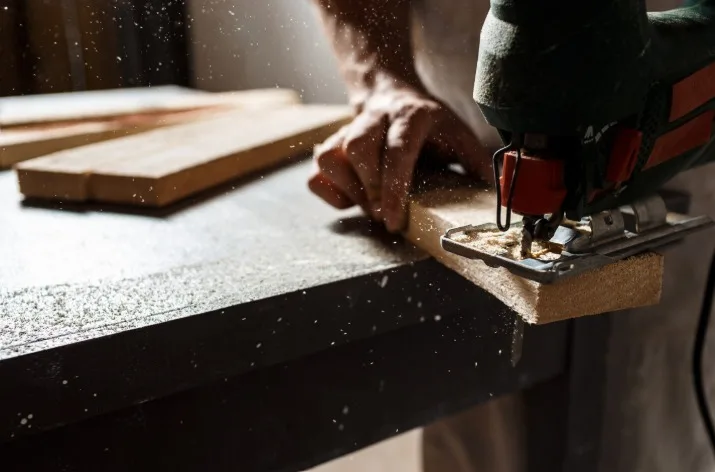
Professional visuals are key. High-quality photography of your projects, whether you’re selling naturemade wood products, custom furniture, or smaller items made with woodworking tools like router bits, helps visitors immediately see the detail and craftsmanship behind your work.
Easy navigation is another must. A site should include a clear homepage, service and product pages, and quick links that help visitors search, browse, and find exactly what they need.
Whether someone is checking price details, looking for great information, or trying to subscribe to your blog posts, short paragraphs and well-structured menus make the experience smooth.
Branding and storytelling also play a huge role. From your logo design to the about page, the site should reflect your values as a craftsman.
Sharing how you source materials, your woodworking journey, or the meaning behind your wood products builds trust and encourages visitors to contact you for custom projects.
For those selling directly, eCommerce functionality is essential. A strong woodworking website allows customers to easily pay online, check out product details, and even join a mailing list to subscribe for updates.
Finally, the extras that keep people coming back: a blog with woodworking tips, tutorials, or guides; forums or comment sections where people can join discussions; and contact forms that make reaching you effortless. These features turn a simple portfolio into a great site that educates, inspires, and builds lasting connections.
Discover: Sustainable Web Design Trends
Build a Stunning Woodworking Website that Highlights Your Craftsmanship!
Our expert web design team specializes in creating professional, client-winning sites for woodworkers.
Best Woodworking Websites to Inspire You
Looking for ideas to shape your own woodworking site?
Here are some of the top woodworking websites that stand out with impressive design, strong branding, and smart features. Each one has something unique you can take inspiration from.
The Joinery
The Joinery is a great example of how simplicity can be powerful. Their clean and minimalist design allows their craftsmanship to shine without distractions.

The site includes high-resolution images of each furniture piece, paired with short paragraphs that tell the story behind the work. When you visit, you can easily navigate through their collections, check out details, and feel the care that goes into every design.
Takeaway: Sometimes less is more. By keeping the layout clean, you highlight premium woodworking services and let the products speak for themselves.
Blacktail Studio
Blacktail Studio has become a household name in woodworking thanks to their popular YouTube channel, and their website extends that same personality.
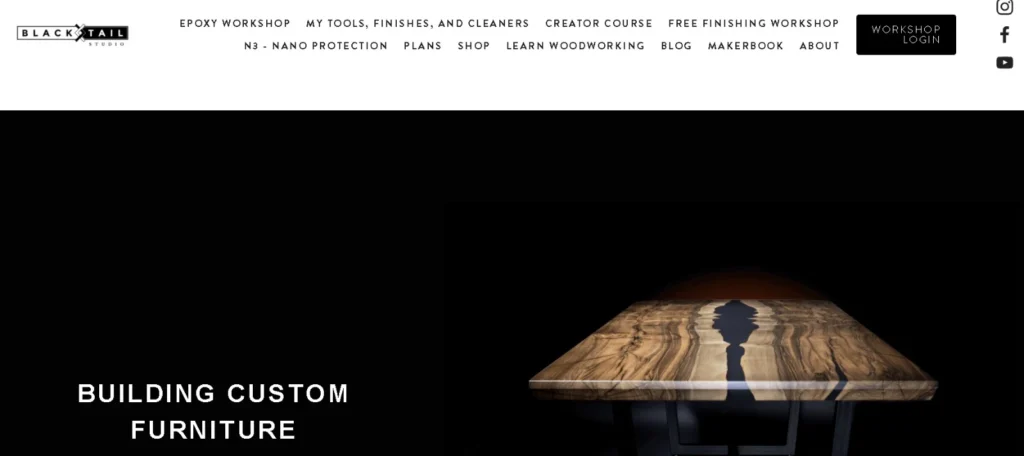
The homepage features custom furniture projects, and the site includes an online store where visitors can pay for handcrafted pieces or woodworking accessories. Their use of videos, great information, and detailed posts builds trust and connects with an audience that’s already familiar with their content.
Takeaway: Personal branding matters. Combining woodworking expertise with strong online presence helps turn followers into loyal customers.
Benchmark Wood Studio
Benchmark Wood Studio takes a portfolio-driven approach, showing off custom carpentry projects with beautiful images and engaging descriptions.
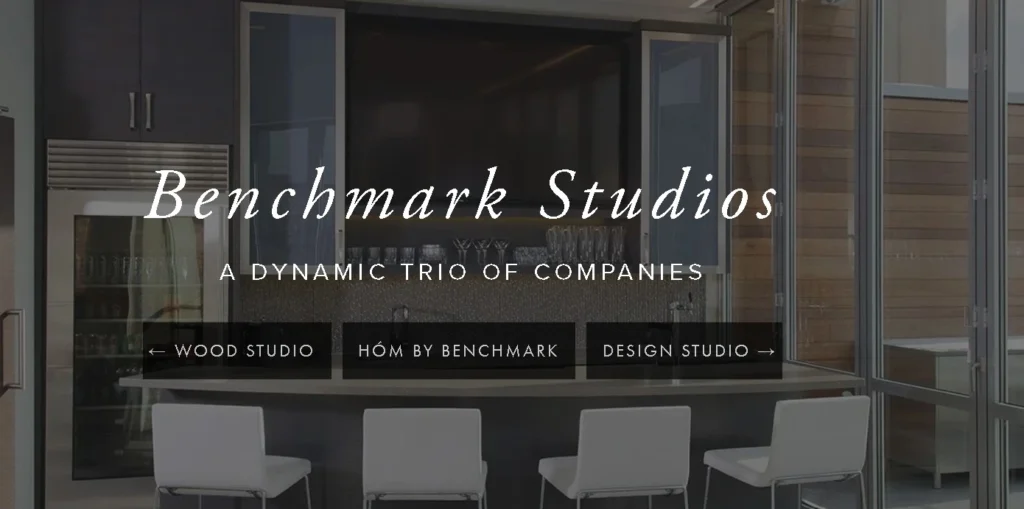
The site also includes customer testimonials and case studies, adding credibility for new visitors who want to see proof of past work. With an easy-to-browse design, clear pricing, and thoughtful detail, this site makes it simple for potential clients to contact the craftsmen.
Takeaway: Highlighting reviews and client stories shows real-world value and helps convince new customers to work with you.
Artisan Born
Artisan Born is all about blending craftsmanship with modern eCommerce. Their site features handmade wood products, from furniture to accessories, displayed with professional photography and lifestyle imagery.
The online shop is easy to navigate, the product descriptions are clear, and visitors can quickly search, add to cart, and pay without hassle. They also use strong branding throughout, from the logo to the page layouts, making the whole experience feel polished.
Takeaway: If you want to scale your woodworking business, combine beautiful craftsmanship with a smooth online store.
Timber Furniture Company
Timber Furniture Company takes a local-first approach. Their site has an inviting, rustic design that matches their brand personality. The homepage introduces their services, while the portfolio gallery showcases projects in detail.
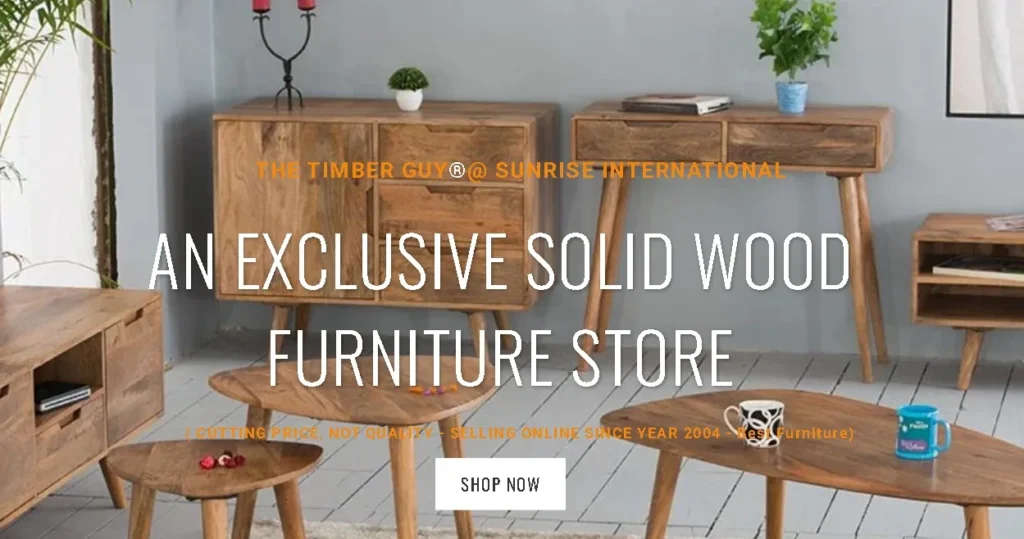
Visitors can explore pages that explain their carpentry process, check prices, and even get in touch directly. With great information and an approachable style, the site builds trust for customers in their community.
Takeaway: Local woodworking businesses can stand out by emphasizing location, craftsmanship, and easy contact options.
Doucette and Wolfe Furniture Makers
Doucette and Wolfe’s website feels timeless, just like their work. It’s designed around storytelling, showcasing heritage woodworking skills passed down through generations.
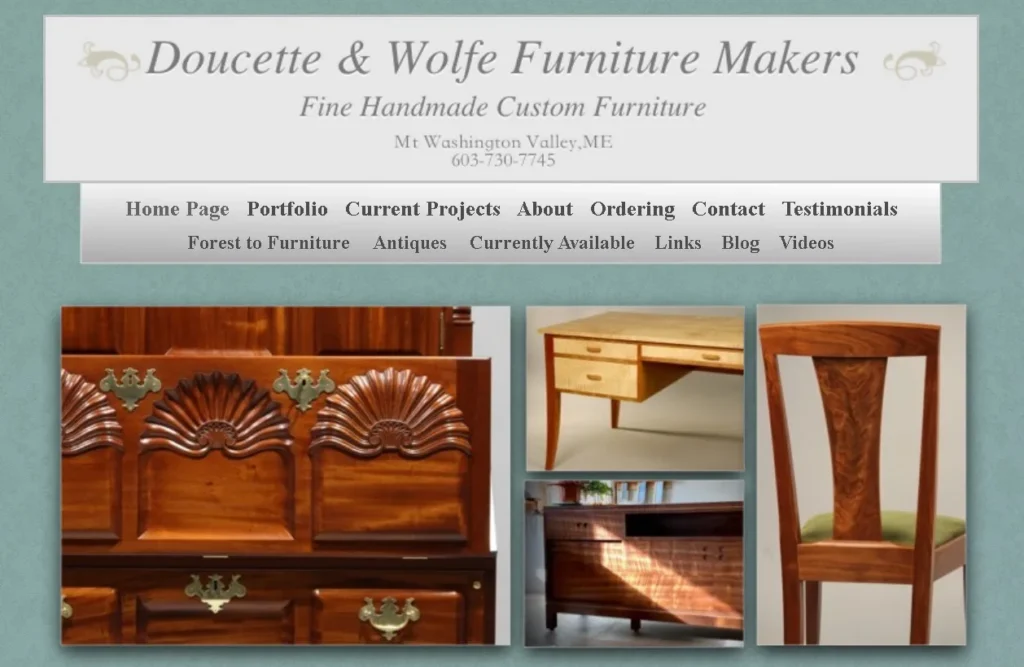
The site includes a project gallery, educational posts, and even videos that give visitors a behind-the-scenes look at their process. The detail in every page makes you feel connected to their craft and reinforces their authority in fine woodworking.
Takeaway: Storytelling creates wonder. Sharing your journey and values can transform your website into more than just a portfolio, it becomes a brand legacy.
Key Takeaways from These Woodworking Websites
When you explore the best woodworking websites, a few common themes stand out. These elements are what make the difference between a basic website and one that truly impresses visitors, builds trust, and drives sales.
Photography Sells Woodworking
Woodworking is a highly visual craft. A photo gallery filled with high-resolution images lets your work shine and tells your story without words.
Whether it’s cutting boards, custom furniture, or nature-made wood products, photography is what convinces potential clients of your skill and attention to detail.
Every great site we reviewed, from The Joinery to Doucette and Wolfe, makes professional photography a core feature.
Blending Portfolio + eCommerce Increases Revenue
Many woodworkers begin with a simple portfolio, but the top woodworking websites also integrate online stores.
By blending a portfolio of past projects with an eCommerce page, you create a space where visitors can be inspired and then immediately purchase. Artisan Born is a great example, they highlight craftsmanship while allowing customers to pay and order directly online.
Consistent Branding Creates Trust
A strong logo, a cohesive color palette, and a consistent tone across every page help woodworking websites stand out. Branding tells visitors who you are before they even read a word.
Sites like Benchmark Wood Studio and Timber Furniture Company keep their branding aligned with their values, creating a sense of trust and professionalism.
Blogging and Educational Content Build Authority and SEO Visibility
Great woodworking websites don’t just showcase projects, they share knowledge. Adding blog posts, tutorials, or even short videos with woodworking tips creates value for visitors and boosts your site’s SEO.
Doucette and Wolfe’s approach of mixing storytelling with educational content positions them as true experts in their field.
Investing in Clean Design Improves Customer Experience
Finally, all of these sites make it easy for visitors to navigate. Clean layouts, short paragraphs, clear links, and simple menus mean users can quickly find prices, contact details, or subscribe for updates.
A great woodworking website feels intuitive and professional, which encourages visitors to stay longer and explore more.
Read Here: Top Web Design Trends
How to Create Your Own Woodworking Website?
So, how can you take these lessons and apply them to your own business? Creating a professional woodworking website doesn’t have to be overwhelming. Here are the key steps to follow:
Choose the Right Platform
Pick a platform that suits your needs. WordPress with WooCommerce is perfect if you want full control and flexibility. Shopify is ideal for eCommerce-focused woodworkers, while Squarespace offers beautifully simple templates for portfolio-driven sites.
Think about your goals, whether that’s selling woodworking tools, showcasing fine carpentry projects, or running woodworking classes, and choose accordingly.
Use Woodworking Themes/Templates
Don’t reinvent the wheel. There are great woodworking themes available that already include features like portfolio galleries, service pages, and online store functionality. A good theme will help your site look polished from the start and ensure every page aligns with your brand identity.
Optimize Images for Speed & SEO
Since woodworking websites rely heavily on visuals, large image files can slow down your site. Use tools to compress photos without losing quality, add alt text with relevant keywords like “woodworking tools” or “handmade furniture,” and ensure images load quickly. Fast sites perform better in search results and keep visitors engaged.
Integrate eCommerce If You Sell Products
If you’re selling wood products, like cutting boards, accessories, or furniture, make sure your site includes eCommerce functionality. Visitors should be able to browse, view product details, check price information, and pay securely without hassle. Including reviews and customer testimonials alongside products builds even more trust.
Add Clear Calls-to-Action (CTAs)
Your website should guide visitors on what to do next. Whether it’s a button to “Request a Custom Project Quote,” a form to contact you, or a prompt to subscribe for updates, CTAs turn casual visitors into real leads or buyers. Place them strategically across your homepage, portfolio, and product pages.
Ensure Mobile Responsiveness
Many people will visit your site from their phone or tablet. A woodworking website that isn’t mobile-friendly risks losing potential customers. Test how your site looks and works across devices to make sure menus, galleries, and payment options are easy to access everywhere.
Also Know: How to Optimize Images and Improve Website Speed
Conclusion
A well-designed woodworking website is more than just an online presence, it’s a showcase of your craft, a sales tool, and a way to connect with your audience. The best woodworking websites we explored prove that thoughtful design, strong visuals, and clear branding make all the difference.
From minimalist sites like The Joinery to eCommerce-driven platforms like Artisan Born, each example shows how important it is to combine storytelling with functionality.
Whether you’re running a local carpentry shop or selling naturemade wood products worldwide, your site should include features like galleries, testimonials, blogs, and easy navigation to give visitors a seamless experience.
If you’re ready to create or upgrade your woodworking website, take inspiration from these examples and apply the best practices we’ve covered.
FAQs About Woodworking Websites
Why do woodworking websites need professional photography?
Because woodworking is all about detail and craftsmanship, high-quality photos highlight the fine textures, joinery, and finishes of your projects. Visitors are more likely to trust your work, and pay premium prices, when they see professional visuals rather than low-quality images.
How can a woodworking website attract more clients?
Beyond a great homepage and photo gallery, features like customer testimonials, reviews, and blog posts build credibility. Adding contact forms, clear pricing, and social media icons encourages visitors to reach out. SEO optimization also ensures people searching for woodworking tools, carpentry services, or custom furniture can find your site.
Do I need eCommerce features if I don’t sell wood products?
Not necessarily. If your woodworking site is more portfolio-based, you can focus on showcasing projects, posting woodworking tutorials, or sharing free woodworking plans. However, adding an option to request a custom quote or subscribe to updates still creates opportunities for future business.
How important is mobile responsiveness for woodworking websites?
Very important. Most visitors browse websites on their phones, and if your site isn’t mobile-friendly, they’ll leave quickly. A responsive design ensures that every page, from your gallery to your contact page, looks great and is easy to navigate on all devices.
Which platform is best for a woodworking website?
It depends on your goals. WordPress + WooCommerce is ideal if you want flexibility, blogging, and full control. Shopify works best for woodworkers focused on selling products in an online store. Squarespace is a good option for simpler portfolio sites with built-in design templates.



